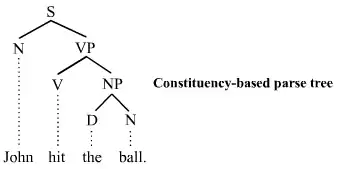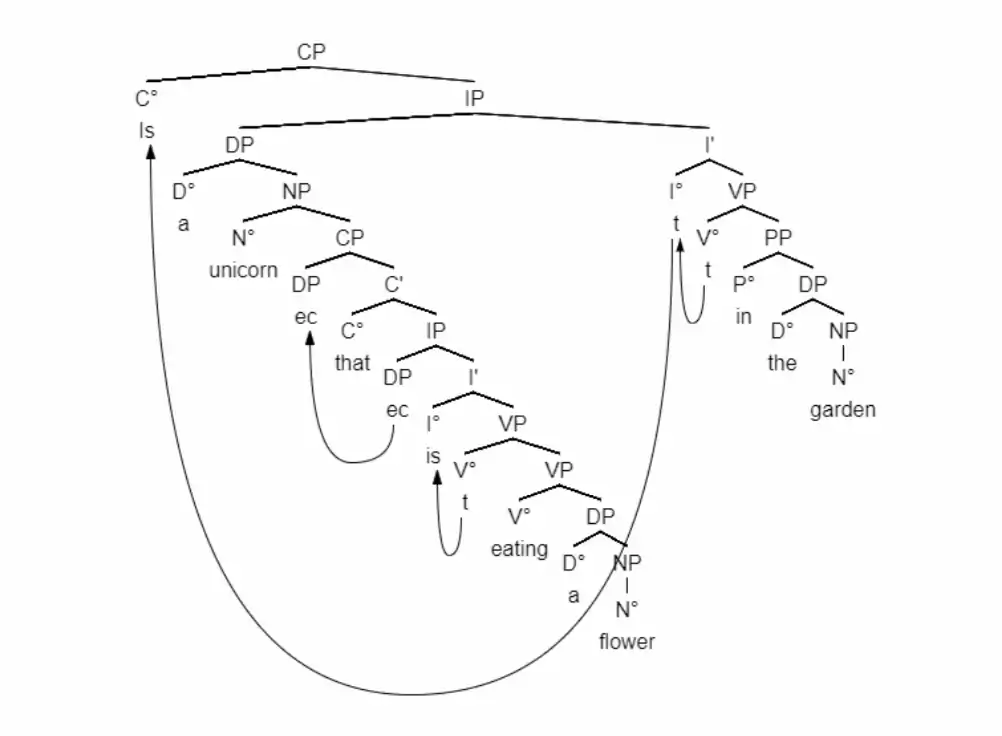Generative grammar
Generative grammar is a concept in generative linguistics, a linguistic theory that regards linguistics as the study of a hypothesised innate grammatical structure.[3] It is a biological,[4] sociobiological[5] or biologistic[6] modification of structuralist theories, deriving ultimately from glossematics.[7][8][lower-alpha 1] Generative Grammar considers grammar as a system of rules that generates exactly those combinations of words that form grammatical sentences in a given language. The difference from structural and functional models is that the object is placed into the verb phrase in generative grammar.[9][10] This purportedly cognitive structure is thought of as being a part of a universal grammar, a syntactic structure which is caused by a genetic mutation in humans.[11]

| Part of a series on |
| Linguistics |
|---|
|
|
Generativists have created numerous theories to make the NP VP (NP) analysis work in natural language description. That is, the subject and the verb phrase appearing as independent constituents, and the object placed within the verb phrase. A main point of interest remains in how to appropriately analyse Wh-movement and other cases where the subject appears to separate the verb from the object.[12] Although claimed by generativists as a cognitively real structure, neuroscience has found no evidence for it.[13][14] In other words, generative grammar encompasses proposed models of linguistic cognition; but as of yet there is no specific indication that these are quite correct.
Frameworks
There are a number of different approaches to generative grammar. Common to all is the effort to come up with a set of rules or principles that formally defines each and every one of the members of the set of well-formed expressions of a natural language. The term generative grammar has been associated with at least the following schools of linguistics:
- Transformational grammar (TG)
- Standard theory (ST)
- Extended standard theory (EST)
- Revised extended standard theory (REST)
- Principles and parameters theory (P&P)
- Monostratal (or non-transformational) grammars
Historical development of models of transformational grammar
Although Leonard Bloomfield, whose work Chomsky rejects, saw the ancient Indian grammarian Pāṇini as an antecedent of structuralism,[15][16] Chomsky, in an award acceptance speech delivered in India in 2001, claimed "The first generative grammar in the modern sense was Panini's grammar".
Generative grammar has been under development since the mid 1950s, and has undergone many changes in the types of rules and representations that are used to predict grammaticality. In tracing the historical development of ideas within generative grammar, it is useful to refer to the various stages in the development of the theory:
Standard theory (1956–1965)
The so-called standard theory corresponds to the original model of generative grammar laid out by Chomsky in 1965.
A core aspect of standard theory is the distinction between two different representations of a sentence, called deep structure and surface structure. The two representations are linked to each other by transformational grammar.
Extended standard theory (1965–1973)
The so-called extended standard theory was formulated in the late 1960s and early 1970s. Features are:
- syntactic constraints
- generalized phrase structures (X-bar theory)
Revised extended standard theory (1973–1976)
The so-called revised extended standard theory was formulated between 1973 and 1976. It contains
- restrictions upon X-bar theory (Jackendoff (1977)).
- assumption of the complementizer position.
- Move α
Relational grammar (ca. 1975–1990)
An alternative model of syntax based on the idea that notions like subject, direct object, and indirect object play a primary role in grammar.
Government and binding/principles and parameters theory (1981–1990)
Chomsky's Lectures on Government and Binding (1981) and Barriers (1986).
Minimalist program (1990–present)
The minimalist program is a line of inquiry that hypothesizes that the human language faculty is optimal, containing only what is necessary to meet humans' physical and communicative needs, and seeks to identify the necessary properties of such a system. It was proposed by Chomsky in 1993.[17]
Context-free grammars
Generative grammars can be described and compared with the aid of the Chomsky hierarchy (proposed by Chomsky in the 1950s). This sets out a series of types of formal grammars with increasing expressive power. Among the simplest types are the regular grammars (type 3); Chomsky claims that these are not adequate as models for human language, because of the allowance of the center-embedding of strings within strings, in all natural human languages.
At a higher level of complexity are the context-free grammars (type 2). The derivation of a sentence by such a grammar can be depicted as a derivation tree. Linguists working within generative grammar often view such trees as a primary object of study. According to this view, a sentence is not merely a string of words. Instead, adjacent words are combined into constituents, which can then be further combined with other words or constituents to create a hierarchical tree-structure.
The derivation of a simple tree-structure for the sentence "the dog ate the bone" proceeds as follows. The determiner the and noun dog combine to create the noun phrase the dog. A second noun phrase the bone is created with determiner the and noun bone. The verb ate combines with the second noun phrase, the bone, to create the verb phrase ate the bone. Finally, the first noun phrase, the dog, combines with the verb phrase, ate the bone, to complete the sentence: the dog ate the bone. The following tree diagram illustrates this derivation and the resulting structure:

Such a tree diagram is also called a phrase marker. They can be represented more conveniently in text form, (though the result is less easy to read); in this format the above sentence would be rendered as:
[S [NP [D The ] [N dog ] ] [VP [V ate ] [NP [D the ] [N bone ] ] ] ]
Chomsky has argued that phrase structure grammars are also inadequate for describing natural languages, and formulated the more complex system of transformational grammar.[18]
Evidentiality
Noam Chomsky, the main proponent of generative grammar, believed to have found linguistic evidence that syntactic structures are not learned but ‘acquired’ by the child from universal grammar. This led to the establishment of the poverty of the stimulus argument in the 1980s. However, critics claimed Chomsky's linguistic analysis had been inadequate.[19] Linguistic studies had been made to prove that children have innate knowledge of grammar that they could not have learned. For example, it was shown that a child acquiring English knows how to differentiate between the place of the verb in main clauses from the place of the verb in relative clauses. In the experiment, children were asked to turn a declarative sentence with a relative clause into an interrogative sentence. Against the expectations of the researchers, the children did not move the verb in the relative clause to its sentence initial position, but to the main clause initial position, as is grammatical.[20] Critics however pointed out that this was not evidence for the poverty of the stimulus because the underlying structures that children were proved to be able to manipulate were actually highly common in children's literature and everyday language.[19] This led to a heated debate which resulted in the rejection of generative grammar from mainstream psycholinguistics and applied linguistics around 2000.[21][22] In the aftermath, some professionals argued that decades of research had been wasted due to generative grammar, an approach which has failed to make a lasting impact on the field.[22]

There is no evidence that syntactic structures are innate. While some hopes were raised at the discovery of the FOXP2 gene,[24][25] there is not enough support for the idea that it is 'the grammar gene' or that it had much to do with the relatively recent emergence of syntactical speech.[26]
Neuroscientific studies using ERPs have found no scientific evidence for the claim that human mind processes grammatical objects as if they were placed inside the verb phrase. Instead, brain research has shown that sentence processing is based on the interaction of semantic and syntactic processing.[13] However, since Generative Grammar is not a theory of neurology, but a theory of psychology, it is completely normal in the field of neurology to find no concreteness of the verb phrase in the brain. In fact, these rules do not exist in our brains, but they do model the external behaviour of the mind. This is why GG claims to be a theory of psychology and is considered to be real cognitively.[27]
Generativists also claim that language is placed inside its own mind module and that there is no interaction between first-language processing and other types of information processing, such as mathematics.[28][lower-alpha 2] This claim is not based on research or the general scientific understanding of how the brain works.[29][30]
Chomsky has answered the criticism by emphasising that his theories are actually counter-evidential. He however believes it to be a case where the real value of the research is only understood later on, as it was with Galileo.[31]
Music
Generative grammar has been used to a limited extent in music theory and analysis since the 1980s.[32][33] The most well-known approaches were developed by Mark Steedman[34] as well as Fred Lerdahl and Ray Jackendoff,[35] who formalized and extended ideas from Schenkerian analysis.[36] More recently, such early generative approaches to music were further developed and extended by various scholars.[37] [38][39][40][41] The theory of generative grammar has been manipulated by the Sun Ra Revival Post-Krautrock Archestra in the development of their post-structuralist lyrics. This is particularly emphasised in their song "Sun Ra Meets Terry Lee". French Composer Philippe Manoury applied the systematic of generative grammar to the field of contemporary classical music.
See also
Notes
- Koerner 1978, p. 41f "it is worth noting that Chomsky cites Hjelmslev's Prolegomena, which had been translated into English in 1953, since the authors theoretical argument, derived largely from logic and mathematics, exhibits noticeable similarities. Cf. Chomsky's Syntactic Structures, which is based on the 1955 manuscript (Chomsky 1957:50), for a direct reference to Hjelmslev, and 115 f., the original [1957] bibliography)."
- Smith 2002, p. 17 "the mind itself is not an undifferentiated general-purpose machine: it is compartmentalized in such a way that different tasks are subserved by different mechanisms. The mind is "modular." Sight and smell, taste and touch, language and memory, are all distinct from each other, from our moral and social judgment, and from our expertise in music or mathematics."
References
- Schäfer, Roland (2016). Einführung in die grammatische Beschreibung des Deutschen (2nd ed.). Berlin: Language Science Press. ISBN 978-1-537504-95-7.
- Butler, Christopher S. (2003). Structure and Function: A Guide to Three Major Structural-Functional Theories, part 1 (PDF). John Benjamins. pp. 121–124. ISBN 9781588113580. Retrieved 2020-01-19.
- Everaert, Martin; Huybregts, Marinus A. C.; Chomsky, Noam; Berwick, Robert C.; Bolhuis, Johan J. (2015). "Structures, not strings: linguistics as part of the cognitive sciences". Trends in Cognitive Sciences. 19 (12): 729–743. doi:10.1016/j.tics.2015.09.008. PMID 26564247. S2CID 3648651. Retrieved 2020-01-05.
- Chomsky, Noam (2017). "The language capacity: architecture and evolution". Psychonomic Bulletin & Review (24): 200–203. doi:10.3758/s13423-016-1078-6. Retrieved 2020-12-17.
- Croft, William (2006). "The relevance of an evolutionary model to historical linguistics". In Nedergaard Thomsen, Ole (ed.). Competing Models of Linguistic Change: Evolution and Beyond. John Benjamins. pp. 91–132. doi:10.1075/cilt.279.08cro.
- Kotowski, Sven; Härtl, Holden (2011). "Recursion and the language faculty - on the evolution of the concept in Generative Grammar" (PDF). Norddeutsches Linguistisches Kolloquium (12): 24–46. Retrieved 2020-12-17.
- Seuren, Pieter A. M. (1998). Western linguistics: An historical introduction. Wiley-Blackwell. pp. 160–167. ISBN 0-631-20891-7.CS1 maint: date and year (link)
- Koerner, E. F. K. (1978). "Towards a historiography of linguistics". Toward a Historiography of Linguistics: Selected Essays. John Benjamins. pp. 21–54.
- Butler, Christopher S. (2003). Structure and Function: A Guide to Three Major Structural-Functional Theories, part 1 (PDF). John Benjamins. pp. 121–124. ISBN 9781588113580. Retrieved 2020-01-19.
- Osborne, Timothy (2015). "Dependency Grammar". In Kiss, Tibor; Alexiadou, Artemis (eds.). Syntax – Theory and Analysis. 2. De Gruyter. ISBN 9783110358667.
- Berwick, Robert C.; Chomsky, Noam (2015). Why Only Us: Language and Evolution. MIT Press. ISBN 9780262034241.
- Kiss, Tibor; Alexiadou, Artemis, eds. (2015). Syntax--theory and analysis: An international handbook. De Gruyter. ISBN 9783110202762.
- Kluender, R.; Kutas, M. (1993). "Subjacency as a processing phenomenon" (PDF). Language and Cognitive Processes. 8 (4): 573–633. doi:10.1080/01690969308407588. Retrieved 2020-02-28.
- Barkley, C.; Kluender, R.; Kutas, M. (2015). "Referential processing in the human brain: An Event-Related Potential (ERP) study" (PDF). Brain Research. 1629: 143–159. doi:10.1016/j.brainres.2015.09.017. PMID 26456801. S2CID 17053154. Retrieved 2020-02-28.
- Bloomfield, Leonard, 1929, 274; cited in Rogers, David, 1987, 88
- Hockett, Charles, 1987, 41
- Chomsky, Noam. 1993. A minimalist program for linguistic theory. MIT occasional papers in linguistics no. 1. Cambridge, Massachusetts: Distributed by MIT Working Papers in Linguistics.
- Chomsky, Noam (1956). "Three models for the description of language" (PDF). IRE Transactions on Information Theory. 2 (3): 113–124. doi:10.1109/TIT.1956.1056813. Archived from the original (PDF) on 2010-09-19.
- Pullum, GK; Scholz, BC (2002). "Empirical assessment of stimulus poverty arguments" (PDF). The Linguistic Review. 18 (1–2): 9–50. doi:10.1515/tlir.19.1-2.9. S2CID 143735248. Retrieved 2020-02-28.
- Pinker, Steven (2007). The language instinct: The new science of language and mind. Harper Perennial Modern Classics. ISBN 9780061336461.
- Fernald, Anne; Marchman, Virginia A. (2006). "27: Language learning in infancy". In Traxler and Gernsbacher (ed.). Handbook of Psycholinguistics. Academic Press. pp. 1027–1071. ISBN 9780080466415.
- de Bot, Kees (2015). A History of Applied Linguistics: From 1980 to the Present. Routledge. ISBN 9781138820654.
- Christensen, Christian Hejlesen. "Arguments for and against the Idea of Universal Grammar". Leviathan: Interdisciplinary Journal in English, 2018: 12–28.
- Scharff C, Haesler S (December 2005). "An evolutionary perspective on FoxP2: strictly for the birds?". Curr. Opin. Neurobiol. 15 (6): 694–703. doi:10.1016/j.conb.2005.10.004. PMID 16266802. S2CID 11350165.
- Scharff C, Petri J (July 2011). "Evo-devo, deep homology and FoxP2: implications for the evolution of speech and language". Philos. Trans. R. Soc. Lond. B Biol. Sci. 366 (1574): 2124–40. doi:10.1098/rstb.2011.0001. PMC 3130369. PMID 21690130.
- Diller, Karl C.; Cann, Rebecca L. (2009). Rudolf Botha; Chris Knight (eds.). Evidence Against a Genetic-Based Revolution in Language 50,000 Years Ago. The Cradle of Language. Oxford Series in the Evolution of Language. Oxford.: Oxford University Press. pp. 135–149. ISBN 978-0-19-954586-5. OCLC 804498749.
- Carnie, Andrew (2013). Syntax. A Generative Introduction. Malden: MA: Blackwell. p. 9. ISBN 9780470655313.
- Smith, Neil (2002). Chomsky: Ideas and Ideals (2nd ed.). Cambridge University Press. ISBN 0 521 47517 1.
- Schwarz-Friesel, Monika (2012). "On the status of external evidence in the theories of cognitive linguistics". Language Sciences. 34 (6): 656–664. doi:10.1016/j.langsci.2012.04.007.
- Elsabbagh, Mayada; Karmiloff-Smith, Annette (2005). "Modularity of mind and language". In Brown, Keith (ed.). Encyclopedia of Language and Linguistics (PDF). Elsevier. ISBN 9780080547848. Retrieved 2020-03-05.
- Chomsky, Noam; Belletti, Adriana; Rizzi, Luigi (January 1, 2001). "Chapter 4: An interview on minimalism". In Chomsky, Noam (ed.). On Nature and Language. Cambridge University Press. pp. 92–161. ISBN 9780511613876. Retrieved 2020-02-28.
- Baroni, M., Maguire, S., and Drabkin, W. (1983). The Concept of Musical Grammar. Music Analysis, 2:175–208.
- Baroni, M. and Callegari, L. (1982) Eds., Musical grammars and computer analysis. Leo S. Olschki Editore: Firenze, 201–218.
- Steedman, M.J. (1989). "A Generative Grammar for Jazz Chord Sequences". Music Perception. 2 (1): 52–77. doi:10.2307/40285282. JSTOR 40285282.
- Lerdahl, Fred; Ray Jackendoff (1996). A Generative Theory of Tonal Music. Cambridge: MIT Press. ISBN 978-0-262-62107-6.
- Heinrich Schenker, Free Composition. (Der Freie Satz) translated and edited by Ernst Ostler. New York: Longman, 1979.
- Tangian, Andranik (1999). "Towards a generative theory of interpretation for performance modeling". Musicae Scientiae. 3 (2): 237–267. doi:10.1177/102986499900300205.
- Tojo, O. Y. & Nishida, M. (2006). Analysis of chord progression by HPSG. In Proceedings of the 24th IASTED international conference on Artificial intelligence and applications, 305–310.
- Rohrmeier, Martin (2007). A generative grammar approach to diatonic harmonic structure. In Spyridis, Georgaki, Kouroupetroglou, Anagnostopoulou (Eds.), Proceedings of the 4th Sound and Music Computing Conference, 97–100. http://smc07.uoa.gr/SMC07%20Proceedings/SMC07%20Paper%2015.pdf
- Giblin, Iain (2008). Music and the generative enterprise. Doctoral dissertation. University of New South Wales.
- Katz, Jonah; David Pesetsky (2009) "The Identity Thesis for Language and Music". http://ling.auf.net/lingBuzz/000959
Further reading
- Chomsky, Noam. 1965. Aspects of the theory of syntax. Cambridge, Massachusetts: MIT Press.
- Hurford, J. (1990) Nativist and functional explanations in language acquisition. In I. M. Roca (ed.), Logical Issues in Language Acquisition, 85–136. Foris, Dordrecht.
- Isac, Daniela; Charles Reiss (2013). I-language: An Introduction to Linguistics as Cognitive Science, 2nd edition. Oxford University Press. ISBN 978-0-19-953420-3.
- "Mod 4 Lesson 4.2.3 Generative-Transformational Grammar Theory". www2.leeward.hawaii.edu. Retrieved 2017-02-02.
- Kamalani Hurley, Pat. "Mod 4 Lesson 4.2.3 Generative-Transformational Grammar Theory". www2.leeward.hawaii.edu. Retrieved 2017-02-02.
